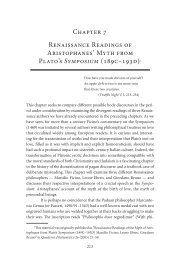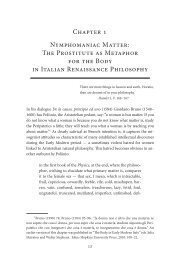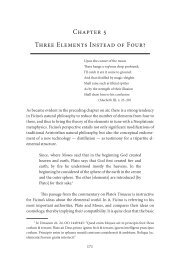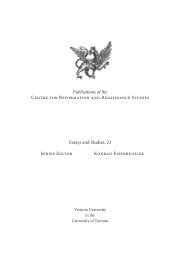Chapter 2 Matter as a Mirror: Marsilio Ficino and Renaissance ...
Chapter 2 Matter as a Mirror: Marsilio Ficino and Renaissance ...
Chapter 2 Matter as a Mirror: Marsilio Ficino and Renaissance ...
You also want an ePaper? Increase the reach of your titles
YUMPU automatically turns print PDFs into web optimized ePapers that Google loves.
98<br />
Disreputable Bodies<br />
If we adopt <strong>Ficino</strong>’s terminology, Plotinus would be on the side of the<br />
perspectivici, where<strong>as</strong>, I think, <strong>Ficino</strong> w<strong>as</strong> inclined to listen to the opinion of<br />
the physici, or natural philosophers, 155 because for him the mirror functions<br />
precisely <strong>as</strong> an image of union <strong>as</strong> well <strong>as</strong> the tool that allows for a conversion<br />
from active into p<strong>as</strong>sive object. In that context, another p<strong>as</strong>sage from Plotinus<br />
w<strong>as</strong> conducive to the idea that mirrors catch (<strong>and</strong> hence retain) images:<br />
And I think that the wise men of old, who made temples <strong>and</strong><br />
statues in the wish that the gods should be present in them,<br />
looking to the nature of the All, had in mind that the nature<br />
of soul is everywhere e<strong>as</strong>y to attract, but that if someone were<br />
to construct something sympathetic to it <strong>and</strong> able to receive a<br />
part of it, it would of all things receive soul most e<strong>as</strong>ily. That<br />
which is sympathetic to it is what imitates it in some way, like<br />
a mirror to catch a form. 156<br />
The above p<strong>as</strong>sage turns out to be of crucial importance to <strong>Ficino</strong>, for<br />
it led him to write his most controversial work, the third part of the De vita,<br />
his influential treatise on magic. 157 (See also chapter three <strong>and</strong> the epilogue<br />
of the present study.) Amongst other things, <strong>Ficino</strong> here tried to establish<br />
the extent to which material images of the gods (again some sort of mirror<br />
images) actually reflect/embody the virtues of their celestial counterparts (an<br />
idea to be found also in the Asclepius 37). In this c<strong>as</strong>e, the mirror functions<br />
<strong>as</strong> a container of souls. Interestingly, the Plotinian p<strong>as</strong>sage cited above st<strong>and</strong>s<br />
next to that author’s only direct mention of the story mirror of Dionysius.<br />
the second theory the things themselves are reflected. Seneca thus implies that the visual<br />
ray is detoured. See Frontisi-Ducroux (1997) 145.<br />
155 On the history of that term, see Keßler (2001) 82, with n. 5.<br />
156 Trans. Plotinus (1966–1988) IV: 71; Enneads IV, 3, 11.<br />
157 According to Kristeller, the De vita is a commentary on Enneads IV, 3 11, where<strong>as</strong><br />
Walker h<strong>as</strong> pointed also to Enneads IV, 4, 30–42. On this, see Copenhaver (1987) p<strong>as</strong>sim,<br />
but esp. 442–443.







